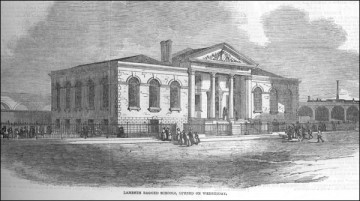 ...there's an awful lot going on. Somebody should make a book about all the things to be found under London's 25 miles of railway arches. The arches are a natural home for wine vaults and fringe theatres. Dodgy car mechanics also thrive in the dark spaces beneath curving Victorian brick, but you can get much more than your car serviced under the arches in Vauxhall, where dubious saunas cosy up to brightly lit cafés and DIY specialists.
...there's an awful lot going on. Somebody should make a book about all the things to be found under London's 25 miles of railway arches. The arches are a natural home for wine vaults and fringe theatres. Dodgy car mechanics also thrive in the dark spaces beneath curving Victorian brick, but you can get much more than your car serviced under the arches in Vauxhall, where dubious saunas cosy up to brightly lit cafés and DIY specialists. Last Sunday we had breakfast at the Café Madeira beneath the viaduct beside the Albert Embankment. I tucked into smoked salmon and scambled egg on foccacia - a bargain at £3.50. Everybody else seemed to be Portuguese. Respectable, decent, hat-wearing folk chatted convivially beneath big wall-mounted LCD screens. A bakery next door turns out dozens of reasonably-priced and tasty-looking Portuguese specialities. Further down the viaduct there's a gay gym, some clubs and several bars, all part of 'Voho' the Vauxhall 'gay village'.
There's even art underneath the arches. Not far from the tourist disappointment that is the Lambeth Walk, the once grand Lambeth Ragged School has been sliced through by the railway. It was built by Henry Benjamin Hanbury Beaufoy FRS in 1851 as a memorial to his wife. Ragged Schools educated 'about 800 children' At the school's opening, Lord Ashley portentously declared that 'there is no reason whatever why Lambeth should not rescue itself from the present disgraceful opprobrium which attaches to it.'
 An art gallery called the Beaconsfield now occupies the one wing that remains of the school, hitting back at the railway by colonising the arch behind. Inside we heard Aura Satz's 'Glissolalia' - a weird and wonderful sound installation featuring disjointed barbershop singers, an endlessly sliding theremin, a musical saw and much else that echoed mysteriously round the high, empty former schoolroom.
An art gallery called the Beaconsfield now occupies the one wing that remains of the school, hitting back at the railway by colonising the arch behind. Inside we heard Aura Satz's 'Glissolalia' - a weird and wonderful sound installation featuring disjointed barbershop singers, an endlessly sliding theremin, a musical saw and much else that echoed mysteriously round the high, empty former schoolroom. The gallery was founded with high-minded ambition of the kind the ragged school's founder would recognise. It aims to “fill a niche between the institution, the commercial and the ‘alternative’”. It isn't exactly welcoming from the outside. In trepidation we pushed the buzzer beside a blank door set into a high wall - but the people inside couldn't have been nicer or more friendly.


 There was an unexpectedly warm welcome at nearby Southbank House too. You can't help being struck by the fabulous Victorian building in Black Prince Road, all ornamented terracotta and glazed tilework set into the window ledges. A frieze over the doorway is one clue to the office block's distinguished past. If you look up, some fading lettering spells out the name 'Doulton'. A smiling caretaker led us to a gallery of photos that tell the story of how John Doulton built a vast business at Lambeth starting from a £100 investment in 1815. The Doultons' fortune was first made in glazed earthenware sewer pipes which saved the city from epdiemics of disease. Doultons then went on to make the fine china that was much admired by Queen Victoria.
There was an unexpectedly warm welcome at nearby Southbank House too. You can't help being struck by the fabulous Victorian building in Black Prince Road, all ornamented terracotta and glazed tilework set into the window ledges. A frieze over the doorway is one clue to the office block's distinguished past. If you look up, some fading lettering spells out the name 'Doulton'. A smiling caretaker led us to a gallery of photos that tell the story of how John Doulton built a vast business at Lambeth starting from a £100 investment in 1815. The Doultons' fortune was first made in glazed earthenware sewer pipes which saved the city from epdiemics of disease. Doultons then went on to make the fine china that was much admired by Queen Victoria.
